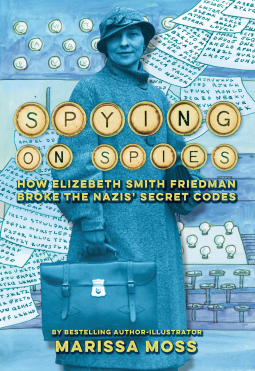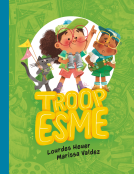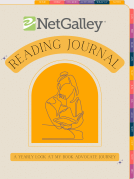
Spying on Spies
How Elizebeth Smith Friedman Broke the Nazis' Secret Codes
by Marissa Moss
This title was previously available on NetGalley and is now archived.
Buy on Amazon
Buy on Waterstones
*This page contains affiliate links, so we may earn a small commission when you make a purchase through links on our site at no additional cost to you.
Send NetGalley books directly to your Kindle or Kindle app
1
To read on a Kindle or Kindle app, please add kindle@netgalley.com as an approved email address to receive files in your Amazon account. Click here for step-by-step instructions.
2
Also find your Kindle email address within your Amazon account, and enter it here.
Pub Date 12 Mar 2024 | Archive Date 12 Apr 2024
ABRAMS Kids | Abrams Books for Young Readers
Talking about this book? Use #SpyingonSpies #NetGalley. More hashtag tips!
Description
Bestselling and award-winning author-illustrator Marissa Moss tells the gripping story of America’s first female cryptanalyst, Elizebeth Smith Friedman, who busted Nazi spy rings.
Praised for her accessible blend of narrative nonfiction with graphic novel-style chapter openers in The Woman Who Split the Atom: The Life of Lise Meitner, Marissa Moss’s Spying on Spies: How Elizebeth Smith Friedman Broke the Nazis’ Secret Codes is another fascinating story of a groundbreaking woman in STEM.
One of the founders of US cryptology who would eventually become one of the world’s greatest code breakers, Elizebeth Smith Friedman (1892–1980) was a brilliant mind behind many important battles throughout the 20th century, saving many lives through her intelligence and heroism.
Whip-smart and determined, Elizebeth displayed a remarkable aptitude for language and recognizing patterns from a young age. After getting her start by looking for linguistic clues to the true authorship of Shakespeare’s writings, she and her husband, William Friedman, were tasked with heading up the first government code-breaking unit in America, training teams and building their own sophisticated code systems during the lead-up to World War I.
Elizebeth’s solo career was even more impressive. She became the Treasury Department’s and Coast Guard’s first female codebreaker and created her own top-notch codebreaking unit, where she trained and led many male colleagues. During Prohibition in the 1920s, her work solving and intercepting coded messages from mobsters and criminal gangs lead to hundreds of high-profile criminal prosecutions, including members of Al Capone’s gang. Her crowning achievement came during World War II, when Elizebeth uncovered an intricate network of Nazi spies operating in South America, a feat that neither law enforcement nor intelligence agencies had been able to accomplish.
Despite her unparalleled accomplishments, Elizebeth was largely written out of history books and overshadowed by her husband. Only in very recent years has her name begun to receive the attention it deserves, including the US Coast Guard naming a ship in her honor and the US Senate passing a 2019 resolution to honor her life and legacy.
Back matter includes codes for kids to learn!
Praised for her accessible blend of narrative nonfiction with graphic novel-style chapter openers in The Woman Who Split the Atom: The Life of Lise Meitner, Marissa Moss’s Spying on Spies: How Elizebeth Smith Friedman Broke the Nazis’ Secret Codes is another fascinating story of a groundbreaking woman in STEM.
One of the founders of US cryptology who would eventually become one of the world’s greatest code breakers, Elizebeth Smith Friedman (1892–1980) was a brilliant mind behind many important battles throughout the 20th century, saving many lives through her intelligence and heroism.
Whip-smart and determined, Elizebeth displayed a remarkable aptitude for language and recognizing patterns from a young age. After getting her start by looking for linguistic clues to the true authorship of Shakespeare’s writings, she and her husband, William Friedman, were tasked with heading up the first government code-breaking unit in America, training teams and building their own sophisticated code systems during the lead-up to World War I.
Elizebeth’s solo career was even more impressive. She became the Treasury Department’s and Coast Guard’s first female codebreaker and created her own top-notch codebreaking unit, where she trained and led many male colleagues. During Prohibition in the 1920s, her work solving and intercepting coded messages from mobsters and criminal gangs lead to hundreds of high-profile criminal prosecutions, including members of Al Capone’s gang. Her crowning achievement came during World War II, when Elizebeth uncovered an intricate network of Nazi spies operating in South America, a feat that neither law enforcement nor intelligence agencies had been able to accomplish.
Despite her unparalleled accomplishments, Elizebeth was largely written out of history books and overshadowed by her husband. Only in very recent years has her name begun to receive the attention it deserves, including the US Coast Guard naming a ship in her honor and the US Senate passing a 2019 resolution to honor her life and legacy.
Back matter includes codes for kids to learn!
A Note From the Publisher
Marissa Moss has written more than 70 children’s books. She is the bestselling author-illustrator of the Amelia’s Notebook series and illustrator of The Eye That Never Sleeps, America’s Tea Parties, Barbed Wire Baseball, and Nurse, Soldier, Spy. Her awards include two California Book Awards, a Eureka! Nonfiction Children’s Book Award Honor, an NCSS/CBC Notable Social Studies Trade Book for Young People, an ALA Notable, and the Cowan Writer’s Prize. She lives in Berkeley, California.
Available Editions
| EDITION | Other Format |
| ISBN | 9781419767319 |
| PRICE | US$19.99 (USD) |
| PAGES | 224 |
Links
Available on NetGalley
NetGalley Shelf App (EPUB)
Readers who liked this book also liked:
You Were Made for This World
Stephanie Sinclair; Sara Sinclair
Children's Nonfiction, Multicultural Interest, Nonfiction (Adult)
Stephanie Sinclair; Sara Sinclair
Children's Nonfiction, Multicultural Interest, Nonfiction (Adult)
The Sea Hides a Seahorse
Sara T. Behrman
Children's Fiction, Outdoors & Nature, Parenting & Families
Sara T. Behrman
Children's Fiction, Outdoors & Nature, Parenting & Families
Bravery Grows
Dr Melissa Giglio; Daisy Geddes
Children's Fiction, Children's Nonfiction, Parenting & Families
Dr Melissa Giglio; Daisy Geddes
Children's Fiction, Children's Nonfiction, Parenting & Families


















